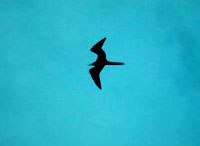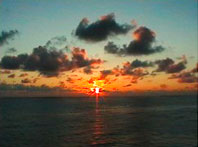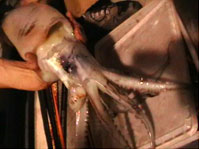

 | |||||||||||||
|
|
Journals 2008/2009Cheryl Manning
January 16, 2009 The last couple of days have been unbelievably busy. Our team is attempting a huge challenge of getting all the core sampled, described and archived before we get to our next site. There is not a lot of time for sight seeing but every day there is something new and the call goes out to get on deck to see the macrofauna (big critters). Birds. There are so many birds at sea. It doesn't matter when you go outside of the labs, you will always see birds. Gulls, sea sparrows, and yes, boobies. Even at night. Here it is 12:30 am., I just came in from watching the half moon rise and off on our port side, there were two gulls flying along with us. They follow ships thinking there will be fresh fish when we pull up our nets. Of course, we don't have fishing nets so they follow us in vain.
Today, the water was incredibly flat and the light reflected off of the surface like an undulating mirror. At one point, someone came in from outside and announced a sighting. Everyone went outside and off on the starboard side about a half a kilometer away the water looked very like water boiling in a pot on a stove. With binoculars we could see tuna and maybe some jumping up out of the water. There must of been hundreds of them swarming on a school of smaller fish. Later, when we all went up on the bow of the ship to watch the sunset, two of the scientists saw rays, one was about 3-4 m across.
Several times in the last few days, dolphins have appeared riding the bow wave of the ship. They leap and dive through the waves then they suddenly disappear back into the water below. Larry Costello works on the coring crew. He does a little fishing every day so he is very observant of what is in the water. Unfortunately, when he isn't working on the long core, we are moving at 11-13 knots so fishing is tough! He came in yesterday after seeing sea turtle swimming along side the ship. Squid appear whenever the ship is stopped. They are drawn in by the lights and sound of the ship. Squid have chromatophores, cells that change color and reflect light so they can be easily seen at night. Microorganisms that live in the water also give off light when they have been disturbed. This is called bioluminescence. At night, when we are moving through the water, the bow wave glows with these little critters.
Several of my shipmates have been following along with this blog. When they comment on it, I ask if I can interview them. Some have said yes, others are too busy to be interviewed but have offered to write something up about how they came to work here and what they do on the R/V Knorr. In the next few weeks, I hope to introduce you to some of these people. Questions:
|
||||||||||||


